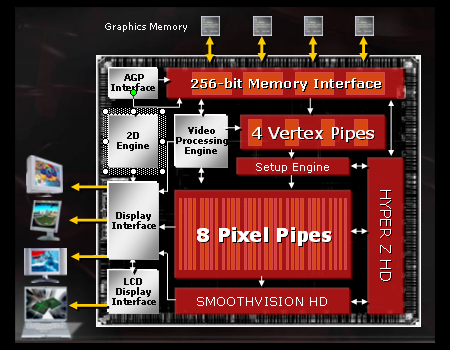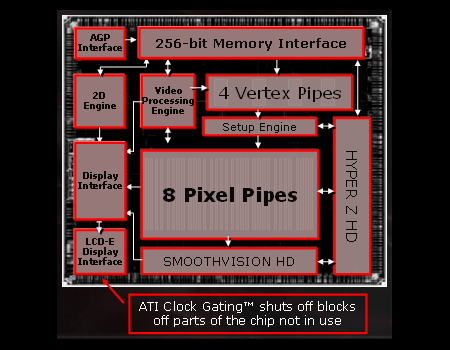ATI Mobility Radeon 9800: Notebooks Get Next Generation Graphics
by Derek Wilson on August 19, 2004 12:05 AM EST- Posted in
- GPUs
Good Things in Small Packages
As indicated earlier, the ATI Mobility Radeon 9800 is based on the R420 core, which powers ATI's latest X800 line of GPUs. In the past, naming may have been a bit of a stretch in terms of comparing mobile graphics solutions with their desktop counterparts, but this time around, the MR9800 bests the desktop 9800 cards in feature set (and doesn't fall that incredibly far behind in performance as we'll soon see).The MR9800 actually supports all the features of the Radeon X800, as it is simply a cut down version of the chip with some enhanced power management features. The real difference between current X800 GPUs on the market and MR9800 is in pixel/vertex pipelines featured. The new mobile chip has 8 pixel pipes and 4 vertex pipes. This also makes the MR9800 look more like a desktop 9800 in fillrate and processing power per clock cycle (though the R420 core will be more efficient). ATI also points to their new chip as the first mobile part to support 256MB of memory using a 256bit wide memory interface. This feature is also a result of the larger power budget available to ATI when targeting the DTR space.
To get a good idea of what's under the hood of MR9800 (and just how alike the desktop X800 really is), here's a block diagram of the chip from ATI's presentation on the part:

Even though ATI had a larger power budget to work with than usual, they couldn't ignore the fact that people will want to be able to use the battery in their system at some point, and thermal and power management both still play a large role in the DTR space. In order to satisfy these needs, ATI's mobile team worked alongside their desktop team to bring power and thermal management features to MR9800 through the R420 design cycle. This allows the R420 to fully support ATI's Powerplay technology right out of the fab. This is why we're seeing the release of a mobile R420 part so soon after the desktop release.
Powerplay is made up of a couple different features. To highlight, we'll touch on a few here. With Power-on-demand, ATI can dynamically adjust clock speeds and voltages based on the usage of the GPU at any given time. This will help to extend battery life when not pushing the graphics subsystem, as will user controlled GPU power management settings. Another important power/thermal management feature of Powerplay is Clock Gating. This amounts to the ability of the GPU to turn off parts of itself when not in use. The granularity of this capability is illustrated in the following slide from ATI's presentation:

We know that in the past, in order to play video, ATI couldn't completely turn off the 3D pipeline, but we are not sure if they have altered this limitation in the MR9800. We'll look into the matter in the future, but this question should answer itself (in video playback tests) when we start seeing reviews of notebooks featuring this GPU.
That does it for the technical details; it's time for some numbers.










31 Comments
View All Comments
ianwhthse - Thursday, August 19, 2004 - link
You know, I think I read it wrong. 256-bit bus width, but no mention of the memory.I think I'm just confusing myself now, so I'll leave it to the experts to tell me off.
ianwhthse - Thursday, August 19, 2004 - link
7 & 8: Dell is currently selling the X800 SE in their Dimension 8400 series (And possibly elsewhere).Looks like the X800 SE is a system-vendor only thing. But it does supposedly have a 256-bit memory.
http://www.xbitlabs.com/news/video/display/2004070...
Xbit labs talks about it. Futuremark (Yeah, yeah, 3dMark sucks. Blah, blah) doesn't currently even have the option to view X800 SEs on their ORB so I would assume they're not out in significant numbers yet.
jcwagers - Thursday, August 19, 2004 - link
Is it just me or does it seem like the UT2k4 benchies are slighly low? I know that it is a tweaked and slightly more demanding version than UT2k3 but surely not by that much. The 3400+ with Radeon 9800XT scores a 51.6fps at 1280x1204? A similar config in earlier reviews ran UT2k3 at 98fps on a 9800 Pro. I know that 1280x1024 is more stressful than 1024x768 and that UT2k4 is more demanding...but should there be THAT much performance loss? I know it was a notebook review but it just seems strange to not see higher fps on the game. Again....maybe it's just me........jc
Johnmcl7 - Thursday, August 19, 2004 - link
It is .13 low-kAs far as I'm aware, ATi did have plans to release this card as the X800SE, but with 128-bit memory rather than 256, but I've not seen any sign of it.
John
nserra - Thursday, August 19, 2004 - link
Why don’t they use GDDR3? It would lower the power consuming, that's important for mobile. Maybe GDDR3 memory banks are bigger?Is this chip .13 lowk, right?
I will wait for the desktop version of this chip. If its 9800 nr on mobile, I bet will do 500Mhz on desktop.
And if it's 256bit it will out do nvidia 6600 since this card is 128bit only.
What will ati call it? X700?
Johnmcl7 - Thursday, August 19, 2004 - link
Dell do not only sell 4,200rpm hard drives in their notebooks, they sell 7,200rpm 60GB hard drives and 5,400 rpm 80GB hard drives as options.Very impressive results from a notebook though, performed better than I expected.
John
Anemone - Thursday, August 19, 2004 - link
Well, I might be a bit too demanding from a poor notebook but, imo, one more generation and probably they will have finally gotten notebook gaming to an ok level. 9800 is pretty good, but I'd prefer to see closer to X800 pro #'s and pci-express changeable interfaces before taking the leap into notebooks.$.02
DerekWilson - Thursday, August 19, 2004 - link
We've updated the article with clock speeds: core 350, mem 300.Most game test are not affected by harddrive speed (except for loading time between levels). None of our tests are significantly affected by harddrive speed (especially with all the system and video ram in the box).
For more info on our farcry tests, see here: http://anandtech.com/video/showdoc.aspx?i=2102 ... we used the airstrip_mp demo as we have been doing since we started testing farcry. We also always test with sound disabled.
Thanks,
Derek Wilson
unuselessj - Thursday, August 19, 2004 - link
I did some looking into the Dell Inspiron XPS specs. Dell's "help me choose" specs say that it does have 256mb ram and a 256-bit bus. On NotebookForums, someone who had tested the XPS with the MR9800 said it comes set to 350mhz core and 300mhz ram.I also noticed that in the specs for the laptop used, the harddrive was an 80gb. Dell only sells 4200rpm drives. Although I'm pretty sure it wouldn't have much of a difference, I'm curious as to what the benchmark results would be if the laptop had a 60gb 7200rpm drive that would be more similar to the desktop's harddrive speed and buffer.
l3ored - Thursday, August 19, 2004 - link
what far cry benchmark is that? i have an athlon 64 3000, 9800 pro, and a gig of memory, and theres no way i would score 40fps average at those settings.